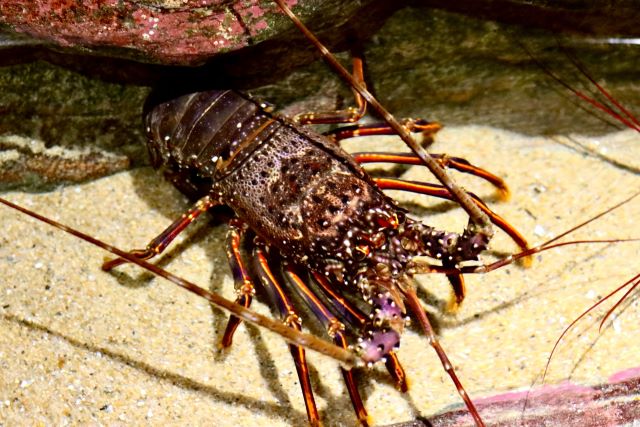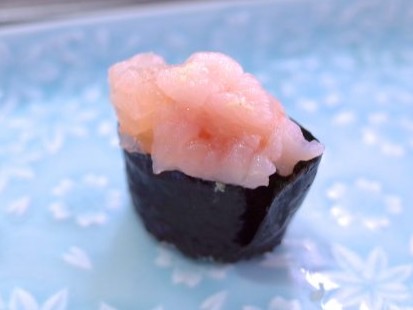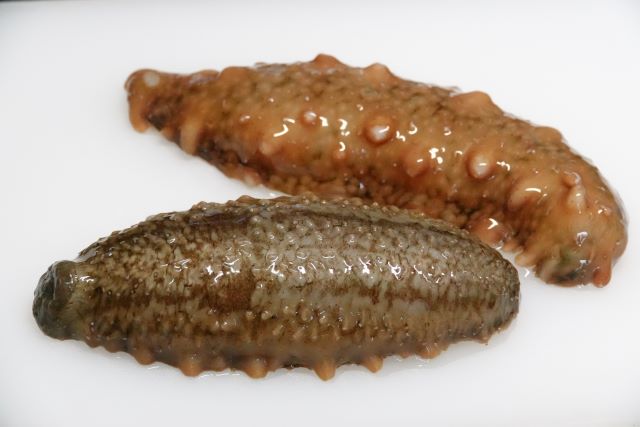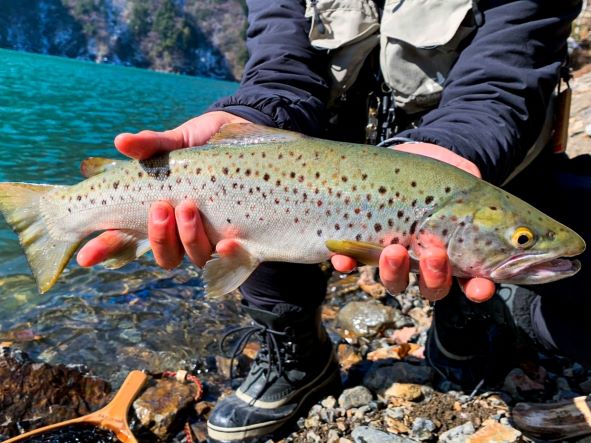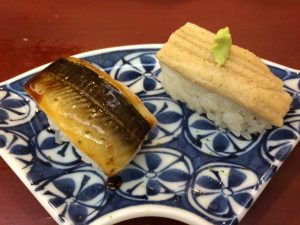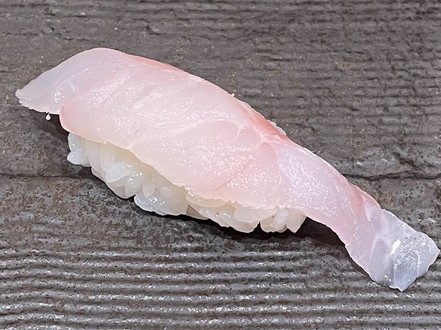Because shiromi has few peculiarities, it is an ingredient that can be easily arranged in a variety of cooking methods, flavors, and combinations with ingredients. The first item recommended to taste is white-flesh fish. Because of its subtle flavor, it doesn’t influence the following topping. Serving it for the very first piece of sushi is a standard move. However, absolute umami in the lightness can be taken as the details Japanese love and no other sushi toppings can offer.
Shiromi refers to white-colored fish meat. The fat content in Shiromi is generally low at about 1.2% in flounder and 4.7% in sea bream. Almost all white fish have a subtle and elegant taste. Furthermore, the rigor mortis takes over slowly and lasts for a long time, so it maintains the crunchy texture longer. Unlike Akami, the Shiromi fish don’t really migrate. You can call yourself a sushi expert if you’re able to recognize which fish it is just by looking at the cut.
Contrary to appearance, Salmon is classified as Shiromi. The salmon is originally grey, and the pink color comes from the pigments of the shrimp and crab on which it preys. We also think that Buri and Shima aji meat looks more beige than white. To be more specific, these are classified as Iromono, but there are relatively few chefs who actually know this term so we will refer to them as Shiromi. Once you’re able to speak knowledgeably on Shiromi, you’ll be a true Sushi Foodie.
What you should keep in mind is that most Shiromi fish used at sushi restaurants is sold as live fish. The broker implements Ikejime according to the instructions of the purchasing shop and then it is delivered. Basically, the chef calculates backward from the time he will make the sushi, aiming to maximize the umami. Furthermore, the price is at least 50% higher, considering the cost to transport from the fishing port to Toyosu Market ,
Of course, only white fish that can be used for nigiri sushi is listed. Many varieties of Fugu exist, but with the exception of Torafugu (Japanese puffer fish), they are mainly used in conveyor belt sushi.
Shiromi has no taste and many people do not like this fish very much. Certainly, in French and Chinese cuisine, where soups and sauces are heavily seasoned, the fish does not need an assertive taste. The appreciation of the dish as a whole is important and does not focus on the fish that make up the dish. In these cuisines, the fish is only part of the Umami substance rather than the flavor.
*Japanese terms will be italicized on sushi ingredients page. Parentheses after the English name indicate the scientific name.
<Shiromi
Aburabouzu Erilepis zonifer (Lockington, 1880)
Aburagarei
Aburatsunozame Squalus suckleyi (Girard, 1855)
Aigo
Aikajika Gymnocanthus intermedius (Temminck & Schlegel, 1843)
Ainame
Akadonko Ebinania vermiculata Sakamoto, 1932
Akaei Red stingray ( Hemitrygon akajei (Müller & Henle, 1841))
Akaeso S ynodus ulae Schultz, 1953)
Akahata
Akahaze Pinkgray goby (Amblychaeturichthys hexanema (Bleeker, 1853)
Akaisaki
Akakasago
Akamanbo (Mandai)
Akame Lates japonicus Katayama & Taki, 1984 )
Akamemodoki Psammoperca waigiensis (Cuvier, 1828)
Akamebaru
Akamefugu
Akamekasago
Akanekintoki Priacanthus blochii Bleeker, 1853
Akatanago Ditrema jordani Franz, 1910
Akatoragisu Yellowbanded red weever (Parapercis aurantiaca Döderlein, 1884
Akauo (Arasukamenuke)
Akayagara
Akodai
Amerikanamazu Ictalurus punctatus (Rafinesque, 1818) )
Anahaze Pseudoblennius percoides Günther, 1861 )
Aobadai Glaucosoma buergeri Richardson, 1845
Aochibiki
Aodai Japanese snapper (Paracaesio caerulea (Katayama, 1934))
Aohata
Aomeeso Chlorophthalmus albatrossis Jordan & Starks, 1904
Aomishima Xenocephalus elongatus (Temminck & Schlegel, 1843)
Aotanago Ditrema viride Oshima, 1940
Aoyagara
Amadai
Amamiushinoshita Brachirus aspilos (Bleeker, 1852)
Amemasu
Amerikanamazu
Amimongara Canthidermis maculata (Bloch, 1786)
Ara
Arameginme Polymixia berndti Gilbert, 1905
Arasukakichiji Sebastolobus alascanus Bean, 1890 )
Arasukamenuke
Arotsunasu Allothunnus fallaii Serventy, 1948)
Asabagarei Lepidopsetta mochigarei Snyder, 1911 )
Ayamekasago
Ayu
Ayukake Rheopresbe kazika (Jordan and Starks, 1904) )
Azukihata
Baitoredfish Centroberyx gerrardi (Günther, 1887)
Bakeakamutsu Randallichthys filamentosus (Fourmanoir, 1970)
Bakemutsu Verilus pacificus (Mochizuki, 1979)
Barafuedai Lutjanus bohar (Forsskål, 1775))
Baramenuke Sebastes baramenuke (Wakiya, 1917) )
Bebizake Oncorhynchus nerka
Benimatoudai Parazen pacificus Kamohara, 1935
Beniteguri Foetorepus altivelis (Temminck & Schlegel, 1845)
Biwamasu
Black bass (Micropterus salmoides (Lacepède,1802))
Bora
Bouzuginpo Zaprora silenus Jordan, 1896
Budai
Burakkubasu (Ookuchibasu)
Buri
Canary chidai Pagrus caeruleostictus (Valenciennes, 1830) )
Chihiroakauo Sebastes fasciatus Storer, 1854)
Chairomaruhata Epinephelus coioides (Hamilton, 1822)
Chigodara Physiculus japonicus Hilgendorf, 1879
Chikamekintoki
Chousenbakama
Comonfugu
Datsu Strongylura anastomella (Valenciennes, 1846) )
Dojou Misgurnus anguillicaudatus (Cantor,1842) )
Dokuurokoibodai Tetragonurus cuvieri Risso, 1810
Ebotai (Ibodai) Pacific rudderfish, Melon seed
Ebisudai
Engawa
Enmagochi Cymbacephalus beauforti (Knapp, 1973)
Ezoisoainame Physiculus maximowiczi (Herzenstein, 1896)
EzoIwana
Ezokusauo
Ezomebaru
Fedai
Fuefukidai Lethrinus haematopterus Temminck & Schlegel, 1844 )
Fugu (Torafugu)
Fusakasago
Fusenkinme Beryx mollis Abe, 1959
Ganko Dasycottus setiger Bean, 1890
Ganzobirame Pseudorhombus cinnamoneus (Temminck and Schlegel,1846) )
Genko Cynoglossus interruptus Günther, 1880
Gima Triacanthus biaculeatus (Bloch, 1786)
Gindara Anoplopoma fimbria (Pallas, 1814) )
Ginhirasu
Ginkagami Mene maculata (Bloch & Schneider, 1801)
Ginmutus (Mazeranainame)
Ginmutus (Raigyodamashi)
Ginpo Pholis nebulosa (Temminck & Schlegel, 1845) )
Ginzake Oncorhynchus kisutch (Walbaum))
Gisu Pterothrissus gissu Hilgendorf, 1877
Gogi
Gomaaigo Siganus guttatus (Bloch, 1787)
Gomafuedai
Gomafugu
Gomatenguhagimodoki Naso maculatus Randall & Struhsaker, 1981
Gonzui Plotosus japonicus Yoshino & Kishimoto, 2008
Gurukun (Takasago ) Pterocaesio digramma (Bleeker, 1864) )
Hachibiki
Hachijoakamutsu Etelis carbunculus Cuvier, 1828
Hakkaku (Tokubire)
Hakofugu Ostracion immaculatus Temminck and Schlegel, 1850 )
Hamadai (Onaga)
Hamafuefukidai (Taman)
Haokoze Hypodytes rubripinnis (Temminck & Schlegel, 1843)
Harisenbon
Hashikinme Gephyroberyx darwinii (Johnson, 1866)
Hatatatedai
Hawaichibiki Erythrocles scintillans (Jordan & Thompson, 1912)
Hedai
Herayagara Aulostomus chinensis (Linnaeus, 1766)
Hibudai
Higanfugu Takifugu pardalis (Temminck and Schlegel, 1850) )
Higedai Long barbeled grunter (Hapalogenys sennin Iwatsuki & Nakabo, 2005
Higesoridai
Hime Hime japonica (Günther, 1877)
Himeaigo Barhead spinefoot (Siganus virgatus (Valenciennes, 1835)
Himekonnayakuuo Careproctus rotundifrons Sakurai & Shinohara, 2008
Himedai
Himefuedai
Himeji Upeneus japonicus (Houttuyn, 1782)
Himemasu Oncorhynchus nerka (Walbaum))
Himeokoz e Minous monodactylus (Bloch & Schneider, 1801))
Hiramasa
Hirame
Hirasuzuki
Hireguromenuke Sebastes borealis Barsukov, 1970 )
Hirejiromanzaiuo Sickle pomfret (Taractichthys steindachneri (Döderlein, 1883)
Hirenagakanpachi Seriola rivoliana Valenciennes,1833 )
Hishidai Antigonia capros Lowe, 1843)
Hitozuraharisenbon
Hiuchidai Hoplostethus japonicus Hilgendorf, 1879
Hoakakuchibi Lethrinus rubrioperculatus Sato, 1978
Hoki
Hokke Hipposcarus longiceps (Valenciennes, 1840)
Horaihimeji Parupeneus ciliatus (Lacepède, 1802))
Hoshiei Short-tail stingray (Bathytoshia brevicaudata (Hutton, 1875))
Hoshigarei
Hoshirenko Cheimerius matsubarai Akazaki, 1962
Hoshisasanohabera
Hoshizame Starspotted smooth-hound ( Mustelus manazo Bleeker, 1855)
Hotarujako Acropoma japonicum Günther, 1859
Hoteiuo Aptocyclus ventricosus (Pallas, 1769)
Houbou Red gurnard (Chelidonichthys spinosus (McClelland, 1844))
Houkihata Epinephelus morrhua (Valenciennes,1833) )
Housenkintoki Priacanthus hamrur (Forsskål, 1775)
Hyugakasago Scorpaenopsis venosa (Cuvier, 1829)
Isagobikunin Liparis ochotensis Schmidt, 1904
Ibarahige
Ichimonjihige Coelorinchus kamoharai Matsubara, 1943
Ikanago Ammodytes japonicus Duncker and Mohr, 1939 )
Inada
Inugochi Percis japonica (Pallas, 1769)
Inunoshita Cynoglossus robustus Günther, 1873
Ira
Irobudai Cetoscarus bicolor (Rüppell, 1829)
Isaki
Ishibirame - Scophthalmus maximus (Linnaeus, 1758) )
Ishidai
Ishigakidai
Ishigakifugu Chilomycterus reticulatus (Linnaeus, 1758) )
Ishigarei
Ishimochi (Shiroguchi)
Isofuefuki (Kuchinaji) Lethrinus atkinsoni Seale, 1910
Isuzumi
Itachiuo Brotula multibarbata Temminck & Schlegel, 1846
Itou
Itoyoridai
Ittoudai Sargocentron spinosissimum (Temminck & Schlegel, 1843) )
Izuhanadai Plectranthias kamii Randall, 1980
Izukasago
Izumidai (Chika)
Kagamidai (Ginmatou)
Kagokakidai
Kagokamasu Rexea prometheoides (Bleeker, 1856)
Kagomatoudai Cyttopsis rosea (Lowe, 1843)
Kaiwari
Kajika
Kamasusawara (Okizawara) Acanthocybium solandri (Cuvier, 1832)
Kanado Lepidotrigla guentheri Hilgendorf, 1879 )
Kanafugu
Kanagashira
Kanpachi
Kantengenge Bothrocara tanakae (Jordan & Hubbs, 1925))
Karafutomasu Oncorhynchus gorbuscha (Walbaum))
Karasu (Gatoro)-
Karasugarei
Kasago
Kasumiaji
Kawabisha Boarfish (Histiopterus typus Temminck & Schlegel, 1844
Kawahagi
Keiji Oncorhynchus keta (Walbaum))
Kemushikajika Hemitripterus villosus (Pallas, 1814)
Kiankou Lophius litulon (Jordan, 1902) )
Kibirekawahagi
Kichinu (Kibire)
Kidai (Renkodai)
Kijihata (Akou)
Kingklip
Kinki (Kichiji)
Kinmedamashi Centroberyx druzhinini (Busakhin, 1981))
Kinmedai
Kintokidai
Kiraraginme Polymixia longispina Deng, Xiong & Zhan, 1983
Kitamakura Canthigaster rivulata (Temminck & Schlegel, 1850) )
Kitanohokke Pleurogrammus monopterygius (Pallas, 1810)
Kitenhata
Kitsunebudai Hipposcarus longiceps (Valenciennes, 1840)
Kitsunedai Bodianus oxycephalus (Bleeker,1862) )
Kitsunemebaru (Mazoi)
Kobanzame Echeneis naucrates (Linnaeus,1758) )
Kobudai
Kobushikajika Malacocottus zonurus Bean, 1890
Kochi (Magochi)
Koganeshimaaji
Kokebirame (Amigarei) Citharoides macrolepidotus Hubbs, 1915
Komonsakatazame Ringstreaked guitarfish ( Rhinobatos hynnicephalus Richardson, 1846)
Korodai
Koshodai
Kouraiakashitabirame Cynoglossus abbreviatus (Gray, 1834))
Kouraimanagatsuo Pampus echinogaster (Basilewsky, 1855) )
Kue
Kujime Hexagrammos agrammus (Temminck and Schlegel,1844))
Kumazasahanamuro Pterocaesio tile (Cuvier, 1830))
Kurakaketoragisu Parapercis sexfasciata (Temminck & Schlegel, 1843)
Kurodai (Chinu)
Kuroguchi Atrobucca nibe (Jordan & Thompson, 1911))
Kurohoshifuedai Lutjanus russellii (Bleeker,1849) )
Kurohoshimanjuudai Scatophagus argus (Linnaeus, 1766)
Kurokoban Remora brachyptera (Lowe, 1839)
Kurokoshodai Plectorhinchus gibbosus (Lacepède, 1802)
Kuromebaru
Kuromejina
Kurosabafugu
Kurosagi
Kuroshibikamasu Promethichthys prometheus (Cuvier, 1832)
Kurosoi
Kurotachikamasu Snake Mackerel (Gempylus serpens Cuvier, 1829
Kurumadai
Kusafugu
Kusakaritsubodai Pentaceros wheeleri (Hardy, 1983)
Kusauo Liparis tanakae (Gilbert & Burke, 1912)
Kiushuhige Coelorinchus jordani Smith & Pope, 1906
Kyuusen Parajulis poecilepterus (Temminck & Schlegel, 1845)
Madaratobiei Spotted eagle ray ( Aetobatus narinari (Euphrasen, 1790))
Maeso Saurida macrolepis Tanaka, 1917
Mafugu
Magarei
Mahata (Hata)
Mahaze
Mahi-mahi (Shiira)
Majeranainame
Majiriaigo
Makogarei
Managatsuo
Manbo Mola mola (Linnaeus, 1758)
Maruaomeeso Chlorophthalmus borealis Kuronuma & Yamaguchi, 1941
Maruhiuchidai Hoplostethus crassispinus Kotlyar, 1980
Marukoban Trachinotus blochii (Lacepède,1801) )
Masunosuke
Matanago Ditrema temminckii Bleeker, 1853
Matoudai Zeus faber Linnaeus, 1758
Matsudai Lobotes surinamensis (Bloch, 1790)
Matsukasauo Monocentris japonica (Houttuyn, 1782)
Matsukawagarei (Matsukawa)
Mebaru
Medai
Meganekasube Beringraja pulchra (Liu, 1932)
Meganemochinouo
Megochi
Mehikari
Meichidai
Meitagarei
Mejika
Mejina
Mejirozame Carcharhinus plumbeus (Nardo, 1827) )
Merurusa (New Zealand heiku)
Menada So-iuy mullet (Planiliza haematocheila (Temminck & Schlegel, 1845)
Miehatanp Pempheris nyctereutes Jordan & Evermann, 1902
Migimaki Cheilodactylus zebra Döderlein, 1883
Miharahanadai Giganthias immaculatus Katayama, 1954
Mikazukitsubameuo Platax boersii Bleeker, 1853
Mimitogeonikasago Scorpaenopsis possi Randall & Eschmeyer, 2001
Minamakurumadai Pristigenys refulgens (Valenciennes, 1862)
Minamaosuzuki
Minamiakame Lates calcarifer (Bloch, 1790) )
Minamiakahige Genypterus blacodes (Forster, 1801) )
Minamihatanpo Pempheris schwenkii Bleeker, 1855
Minamihoubou Chelidonichthys kumu (Cuvier, 1829) )
Minamikagokamasu
Minamikintoki
Minamikurosagi Gerres oyena (Forsskål, 1775)
Minamioosuzuki Polyprion oxygeneios (Schneider & Forster) )
Minokasago Butterfly fish, Lion fish (Pterois lunulata Temminck and Schlegel, 1844)
Mishimaokoze
Murasoi Sebastes pachycephalus Temminck & Schlegel 1843 )
Mutsu
Mutsugoro Boleophthalmus pectinirostris (Linnaeus, 1758))
Nagamenuke Sebastes (Sebastes) variabilis (Pallas, 1814)
Nagaoomehata Malakichthys elegans Matsubara & Yamaguti, 1943
Nagatachikamasu Thyrsitoides marleyi Fowler, 1929
Namazu Silurus asotus Linnaeus, 1758 )
Nametagarei (Babagarei)
Nanyokinme Beryx decadactylus Cuvier, 1829
Nashifugu Takifugu vermicularis (Temminck & Schlegel, 1850)
Narutobiei Aetobatus narutobiei White, Furumitsu & Yamaguchi, 2013)
Natsubirame
Nezumifugu
Nezumigochi (Megochi)
Nezumizame (Moukazame) Lamna ditropis Hubbs & Follett, 1947
Nibe
Nijikajika Alcichthys elongatus (Steindachner, 1881)
Nijimasu
Nikko Iwana
Nile akame (Nile perch) Lates niloticus (Linnaeus, 1758) )
Niseokikasago Helicolenus fedorovi Barsukov, 1973
Nishiankou Lophius piscatorius Linnaeus, 1758 )
Nizadai
Nodoguro (Akamutsu)
Norogenge Bothrocara hollandi (Jordan & Hubbs, 1925)
Numagarei Platichthys stellatus (Pallas, 1787)
Ohyô (ohyou)
Ojisan
Okamuraginme Polymixia sazonovi Kotlyar, 1992
Okiakauo Sebastes mentella Travin, 1951 )
Okikasago Helicolenus avius Abe & Eschmeyer, 1972
Okinawakurumadai
Okimebaru
Okimedai Seriolella caerulea Guichenot, 1848)
Okinahimeji Parupeneus spilurus (Bleeker, 1854))
Okinamejina
Okitoragisu Parapercis multifasciata Döderlein, 1884
Okoze (Oniokoze)
Ookamiuo Anarhichas orientalis Pallas, 1814
Ookuchihamadai Etelis radiosus Anderson, 1981
Ookuchiishinagi Stereolepis doederleini Lindberg & Krasyukova, 1969 )
Oomehata Malakichthys griseus Döderlein, 1883
Oomonhata Epinephelus areolatus (Forsskål, 1775) )
Oomematoudai
Oonibe
Oosaga Sebastes iracundus (Jordan and Starks, 1904) )
Oourumakasago Scorpaenopsis oxycephala (Bleeker, 1849)
Onidarumaokoze- Synanceia verrucosa Bloch & Schneider, 1801 )
Onihige Coelorinchus gilberti Jordan & Hubbs, 1925
Onihiraaji
Onikajika Enophrys diceraus (Pallas, 1787)
Onikanagashira Lepidotrigla kishinouyei Snyder,1911 )
Onikasago
Onisokohoubou Pterygotrigla multiocellata (Matsubara, 1937)
Peherei Odontesthes bonariensis (Valenciennes, 1835))
Raigyodamashi
Ribonkasube Bathyraja diplotaenia (Ishiyama, 1952)
Rousokuchibiki Emmelichthys struhsakeri Heemstra & Randall, 1977
Saburo Occella iburia (Jordan & Starks, 1904)
Sagamisokodara Ventrifossa garmani (Jordan & Gilbert, 1904)
Sakatazame Rhinobatos schlegelii Müller & Henle, 1841
Sake Oncorhynchus keta (Walbaum))
Sakebikunin- Careproctus rastrinus Gilbert & Burke, 1912
Sakegashira Trachipterus ishikawae Jordan & Snyder, 1901
Sakuradai Sacura margaritacea (Hilgendorf, 1879) )
Sakuramasu
Salmon trout
Samegarei
Sankomenuke Sebastes flammeus (Jordan & Starks, 1904) )
Sasaushinoshita Heteromycteris japonicus (Temminck & Schlegel, 1846)
Satsuomishima Ichthyscopus pollicaris Vilasri, Ho, Kawai & Gomon, 2019
Sawara
Sennendai
Setodai
Setoushinoshita Pseudaesopia japonica (Bleeker, 1860)
Shichirouo Brachyopsis segaliensis (Tilesius, 1809)
Shiira
Shima aji
Shimafugu
Shimagatsuo (Ethiopia) Brama japonica Hilgendorf, 1878
Shimaisaki
Shimaushinoshita Zebrias zebrinus (Temminck & Schlegel, 1846)
Shimazoi Sebastes trivittatus Hilgendorf, 1880 )
Shinshu salmon
Shirasu
Shirobuchihata
Shirogenge Bothrocara molle Bean, 1890
Shirohirasu
Shirokasago Setarches guentheri Johnson, 1862
Shirokurabera (Makubu) Choerodon schoenleinii (Valenciennes, 1839))
Shiromebaru
Shirosabafugu (Sabafugu)
Shirosuzuki
Shirozake (Shake)
Shirozame Spotless smooth-hound ( Mustelus griseus Pietschmann, 1908)
Shitabirame
Shosaifugu
Silver Seriolella punctata (Forster, 1801) )
Sirouo
Sukesoudara
Sokoamadai Owstonia totomiensis Tanaka, 1908
Sokoamadaimodoki Owstonia japonica Kamohara, 1935
Sokohoubou Pterygotrigla hemisticta (Temminck & Schlegel, 1843)
Sokogangiei Bathyraja bergi Dolganov, 1983
Sokoitoyoridai
Sugi
Sujiara
Sumikuiuo Synagrops japonicus (Döderlein, 1883)
Sunagarei Limanda punctatissima (Steindachner, 1879))
Suzuki
Suzumedai
Tai (Madai)
Tairikusuzuki Lateolabrax maculatus (McClelland, 1844) )
Taiseiyouakauo
Taiseiyosake
Takabe Labracoglossa argentiventris Peters,1866 )
Takanohadai
Takasago (Gurukun)
Takenokomebaru Sebastes (Sebastocles) oblongus Günther, 1877)
Tamaganzoubirame Pseudorhombus pentophthalmus Günther, 186
Tamagashira Monocle-bream, Redbelt monocle-bream (Parascolopsis inermis (Temminck & Schlegel, 1843))
Tamakai
Tamameichi
Tanakagenge Lycodes tanakae Jordan & Thompson, 1914
Tanukimebaru Sebastes zonatus Chen & Barsukov, 1976 )
Tara (Madara)
Tengudai
Tenguhagi Naso unicornis (Forsskål, 1775) )
Tengunotachi Eumecichthys fiski (Günther, 1890)
Tenjikutachi
Tenjikudai Jaydia lineata (Temminck & Schlegel, 1842)
Tobiei Myliobatis tobijei Bleeker, 1854)
Tobihata Triso dermopterus (Temminck and Schlegel,1842))
Tobinumeri-
Togekanagasira Lepidotrigla japonica (Bleeker,1854) )
Togottomebaru Sebastes joyneri Günther, 1878
Tokageeso Saurida elongata (Temminck & Schlegel, 1846)
Tokishiazu (Toki) Oncorhynchus keta (Walbaum))
Tomomehikari Chlorophthalmus acutifrons Hiyama, 1940
Tonboinugochi Percis matsuii Matsubara, 1936
Torafugu
Toragisu Parapercis pulchella (Temminck & Schlegel, 1843) )
Toujin (Tôjin)
Tsubamekonoshiro Polydactylus plebeius (Broussonet, 1782)
Tsubameuo Platax teira (Forsskål, 1775)
Tsubodai Pentaceros japonicus Steindachner, 1883 )
Tsuchihozeri Epinephelus cyanopodus (Richardson, 1846) )
Tsumaguroaomeeso Chlorophthalmus nigromarginatus Kamohara, 1953
Tsumagurokajika Gymnocanthus herzensteini Jordan & Starks, 1904
Tsumuburi Elagatis bipinnulata (Quoy & Gaimard, 1825) )
Tsrugiechiopia Taractes rubescens (Jordan & Evermann, 1887)
Ukkarikasago
Umazurahagi
Umeiro-
Umeiromodoki-
Umihigoi Parupeneus chrysonemus ( & , ))
Umitanago Ditrema temminckii subsp. temminckii
Urohaze Glossogobius olivaceus (Temminck & Schlegel, 1845)
Urokogarei Lepidoblepharon ophthalmolepis Weber, 1913
Usubahagi
Usumebaru
Utsubo
Wakiyahata Malakichthys wakiyae Jordan & Hubbs, 1925
Wanieso Saurida wanieso Shindo & Yamada, 1972
Wanigochi
Warasubo Odontamblyopus rubicundus (Hamilton, 1822)
Yaitohata
Yamato Iwana -
Yanagimebaru Sebastes itinus (Jordan & Starks, 1904)
Yanagimushigarei Tanakius kitaharae (Jordan & Starks, 1904) )
Yagishirikajika Eurymen gyrinus Gilbert & Burke, 1912
Yanagimebaru Sebastes itinus (Jordan & Starks, 1904) )
Yanaginomai -
Yanbarushimaaodai Paracaesio stonei Raj & Seeto, 1983)
Yarimanbo Sharptail Mola (Masturus lanceolatus (Liénard, 1840)
Yarinumeri-
Yokosujifuedai
Yoritofugu
Yoroiitatiuo (Higedara) Hoplobrotula armata (Temminck and Schlegel, 1846) )
Yosujifuedai
Yukatahata Coral hind (Cephalopholis miniata (Forsskål, 1775))
Yumekasago
Yumetachimodoki Evoxymetopon taeniatus Gill, 1863
Yuudachitakanoha Cheilodactylus quadricornis Günther, 1860
[sc_apply url=”https://sushiuniversity.jp/apply/”]
We hope this information will be helpful.
Revision date: February 13, 2025
Share this article
